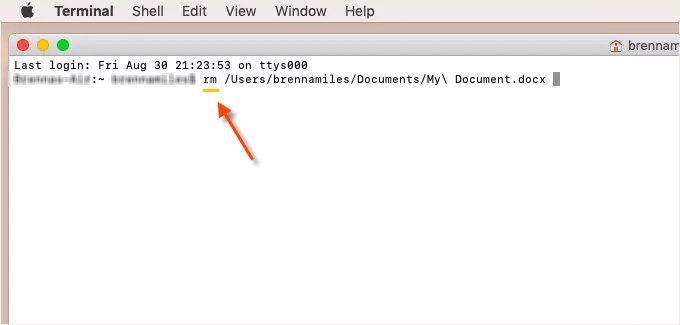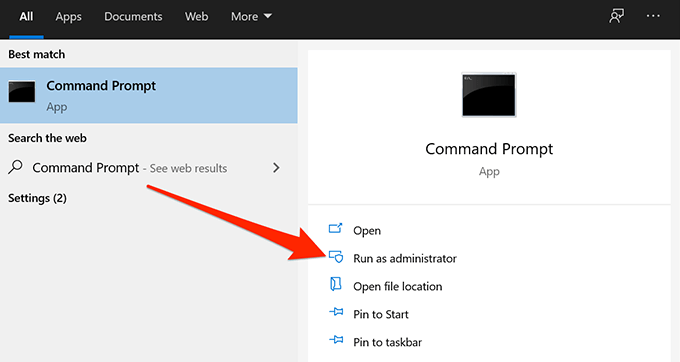

- #MAC COMMAND LINE DELETE FILE HOW TO#
- #MAC COMMAND LINE DELETE FILE MAC OS X#
- #MAC COMMAND LINE DELETE FILE WINDOWS 10#
- #MAC COMMAND LINE DELETE FILE PLUS#
- #MAC COMMAND LINE DELETE FILE MAC#
Or perhaps you know of a program on some website, that I can download to my Windows 10 laptop, that will do it for me. I open a CMD window and have the ASUS drive, (drive F) ready for the proper command sequence if there is one. So…I pulled the SATA drive, attached USB 2.0 interface cable, and am now trying to repair the registry from another windows (10) laptop. So I can’t fix corrupted registry with commands. The UBCD4WIN disk is useless there as well as all repair disks and Windows Repair disks. At the top of the window, you will see the word Bash it stands for 'Bourne again. The command line shown is ComputerName:CurrentDirectory Username. A window will open, and you will see a command prompt ending with a. You can use terminal by opening Finder > Applications > Utilities > Terminal.
#MAC COMMAND LINE DELETE FILE HOW TO#
Laptop will not boot to CD/DVD drive, though I have used f12 to change boot config. How to Open Terminal (Command Prompt) on Mac. Repair report says: “Registry is corrupt” Fix: “Registry rollback”. MS repair says it “cannot make the necessary repairs”. tried f8, safe mode with command prompt every option offered there starts and then returns to BSOD. OptionBrightness Up: Open Displays preferences. Delete File with Particular Extension The command will help you remove all the files, followed by the file extension that you want to remove from the computer. Note: In the above command, you can replace the 'image' with any other name.
#MAC COMMAND LINE DELETE FILE MAC#
CommandBrightness Down: Turn video mirroring on or off when your Mac is connected to more than one display. Press 'Y' and 'Enter' to execute the command. Option-Shift-Command-Delete: Empty the Trash without confirmation dialog. reg delete "Registry_key_path" /v Registry_value_name /fĬommand to delete the registry value ‘ TSAdvertise‘ under the registry key ‘HKEY_LOCAL_MACHINE\SYSTEM\CurrentControlSet\Control\Terminal Server’ reg delete "HKEY_LOCAL_MACHINE\SYSTEM\CurrentControlSet\Control\Terminal Server" /v TSAdvertise /f Delete a registry keyĭelete all registry keys and values under a registry key: reg delete Registry_key_pathĭelete all the registry values under the key ‘HKEY_CURRENT_USER\Software\Microsoft\Windows\CurrentVersion\Applets\Regedit\Favorites’ reg delete HKEY_CURRENT_USER\Software\Microsoft\Windows\CurrentVersion\Applets\Regedit\Favoritesĭelete all registry values under a registry key reg delete RegistryKey /vaĪSUS laptop crashes on every boot. Command-Delete: Move the selected item to the Trash. If the registry key has space in its name, you can use double quotes as below. reg delete Registry_key_path /v Registry_value_name /fįor the above example, the command to delete the registry value without any confirmation prompt: c:\> reg delete HKEY_CURRENT_USER\Software\Microsoft\Windows\CurrentVersion\Explorer /v CleanShutdown /f

If you want to delete registry key without being prompted for confirmation then add /f switch to the command. Read more about bypass trash, delete, File, immediately, macOS.C:\> reg delete HKEY_CURRENT_USER\Software\Microsoft\Windows\CurrentVersion\Explorer /v CleanShutdownĭelete the registry value CleanShutdown (Yes/No)? yes Follow this answer to receive notifications. or other commands in place of -delete as show in previous answer. Oh, and sudo to convince the Mac to let you change those permissions in the first place. To do this in the current directory you can do. Click on the Finder icon on your Dock, then select one or more files in the Finder. For now, the few commands you’ll need are cd to change directories to where the app, file or folder can be found, chflags to change that darn locked flag, then rm to remove the program or file.

#MAC COMMAND LINE DELETE FILE MAC OS X#
How do I delete ssh key file called /.ssh/aws.sg.pub using the terminal on Apple Mac OS X You can use rm command to delete the file from your local Mac based system. There are two methods, one using a menu command, the other using a keyboard shortcut. I have aws.sg.pub and ibm.sl.pub file for ssh login. Here are instructions on how to delete files immediately.
#MAC COMMAND LINE DELETE FILE PLUS#
To use it, type rm plus the name ofthe item(s) you want to delete. Now that Apple has provided a one-step process, please use it carefully. The rm (remove) command deletes files and directories. If deleting a file were a one-step process, this could increase the chance of accidentally deleting the wrong file.

First, move the file to the Trash, then empty the Trash. Did you know that you can bypass using your Mac’s Trash and simply delete a file immediately? Somehow I failed to learn that Apple added this feature in 2015 with OS X El Capitan (aka OS X 10.11).ĭeleting a file is usually a two step process.


 0 kommentar(er)
0 kommentar(er)
